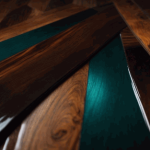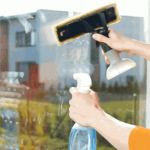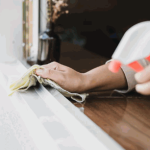Epoxy flooring has been gaining popularity for its durability, easy maintenance, and customizable design options. But is it suitable for living rooms? We will explore the benefits of epoxy flooring, factors to consider before using it in living rooms, how to prepare the room for installation, the installation process, and tips for maintaining epoxy flooring in living rooms. If you’re considering upgrading your living room flooring, this article will provide you with everything you need to know about epoxy flooring.
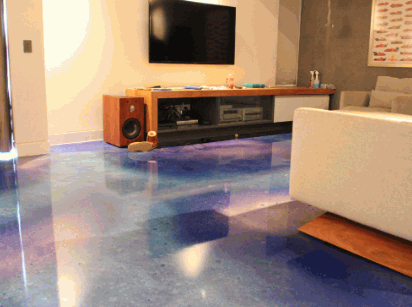
What Is Epoxy Flooring?
Epoxy flooring is a versatile flooring solution that involves the application of a durable resin or polymer to create a seamless surface finish.
Known for its exceptional durability and resistance to chemicals, epoxy flooring is a popular choice for various settings such as garages, warehouses, and industrial spaces. The composition of epoxy flooring typically consists of a base resin and a hardener that, when mixed, creates a strong bond that can withstand heavy foot traffic and mechanical loads.
The seamless nature of epoxy flooring not only enhances its durability but also makes it easy to clean and maintain. With a wide range of colours, patterns, and finishes available, epoxy flooring offers endless design options to achieve a high-quality surface finish that is both visually appealing and functional.
Explore in-depth: Can You Put Resin On Wood Floors
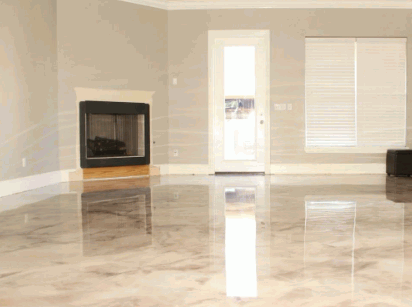
What Are The Benefits Of Epoxy Flooring?
Epoxy flooring offers a range of benefits including exceptional durability, appealing aesthetics, easy maintenance, and cost-effectiveness.
Durability
One of the key advantages of epoxy flooring is its exceptional durability, making it resilient, long-lasting, and highly resistant to impacts and scratches.
Epoxy flooring is especially well-suited for high-traffic areas such as garages, industrial spaces, and commercial establishments due to its ability to withstand constant use. Its impact resistance means it can endure heavy machinery and equipment without showing signs of wear. The scratch-resistant properties of epoxy flooring make it a practical choice for areas where furniture or tools may be moved around frequently. This durability ensures that epoxy flooring provides a cost-effective, low-maintenance, and aesthetically pleasing flooring solution for both residential and commercial settings.
Easy Maintenance
Epoxy flooring is known for its easy maintenance due to its stain-resistant properties, ease of cleaning, and overall low maintenance requirements.
This makes it an excellent choice for high-traffic areas in both residential and commercial settings. With its seamless surface, epoxy flooring prevents the accumulation of dirt and grime, making it simple to wipe or mop clean. Its resistance to stains means spills can be quickly wiped up without leaving any lasting marks. The minimal maintenance required for epoxy flooring translates to cost savings and less time spent on upkeep, allowing for a durable and attractive flooring option that remains in pristine condition with little effort.
Customisable Design
Epoxy flooring offers a customisable design aspect with a variety of design options, making it versatile, decorative, and suitable for custom designs.
With epoxy flooring, the design possibilities are endless, allowing individuals to transform their spaces into unique and visually striking areas. Whether you prefer a sleek and modern look or a more vibrant and artistic design, epoxy flooring can be tailored to meet your specific preferences.
From metallic finishes to decorative flakes and even custom patterns or logos, epoxy floors offer a wide range of decorative elements for creating a personalised touch in any indoor setting. By combining colours, textures, and finishes, epoxy flooring can help elevate the overall aesthetics of a room while also providing durability and easy maintenance.
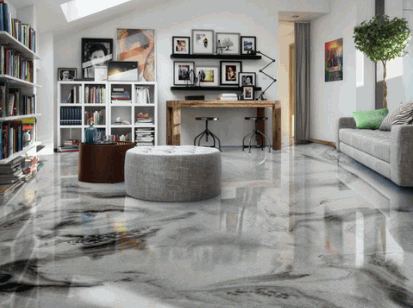
Resistance To Stains And Chemicals
Epoxy flooring exhibits remarkable resistance to stains and chemicals, providing a protective layer that safeguards the underlying surface.
This protective layer not only ensures that spills can be quickly and easily cleaned up, but it also contributes to the overall value of the property. Homeowners and businesses alike appreciate the durability and low maintenance of epoxy flooring, making it a popular choice for high-traffic indoor areas.
The ability of epoxy flooring to resist stains and chemicals not only keeps the space looking fresh and clean but also extends the lifespan of the flooring, reducing the need for costly replacements. This added protection gives property owners peace of mind knowing that their floors are well-equipped to handle daily wear and tear.
Is Epoxy Flooring Suitable For Living Rooms?
Epoxy flooring is a popular choice for living rooms as it enhances the ambiance, comfort, and overall appearance of indoor spaces.
Its seamless finish not only contributes to a stylish and modern look but also provides a durable and easy-to-maintain surface, perfect for high-traffic areas like living rooms.
The wide range of colours and designs available in epoxy flooring allows homeowners to create a personalised space that complements their decor style.
The smooth texture of epoxy flooring adds a touch of sophistication to the living room, making it a versatile and practical option for those looking to elevate the aesthetics of their home.

What Are The Factors To Consider Before Using Epoxy Flooring In Living Rooms?
Before opting for epoxy flooring in living rooms, it’s essential to consider factors such as renovation requirements, interior design compatibility, and overall aesthetic appeal.
Renovation needs to play a crucial role in determining whether epoxy flooring is the right choice for your living space. Assess the condition of the existing flooring and any potential structural issues that may need addressing before installation.
Think about how the new flooring will blend in with your current interior design scheme. Matching colours, textures, and styles can create a cohesive look that elevates the room’s ambiance. Consider the overall aesthetic you wish to achieve; epoxy flooring offers versatility in design options, from modern and sleek to rustic and industrial.
How To Prepare The Living Room For Epoxy Flooring?
Preparing the living room for epoxy flooring involves steps like clearing and cleaning the room, repairing any damages, and leveling the floor to ensure a smooth installation process.
Clearing the room involves removing all furniture, decorative items, and any potential obstacles that may hinder the installation process. It is crucial to have a clean and dust-free surface before proceeding with epoxy flooring.
Preparing the floor also includes inspecting for any cracks, holes, or uneven areas that need to be repaired prior to applying the epoxy. Ensuring a level surface is essential as it not only enhances the aesthetic appeal but also contributes to the longevity and durability of the epoxy finish.

Clearing And Cleaning The Room
Clearing and cleaning the living room is the initial step in preparing for epoxy flooring, ensuring a clean and debris-free surface for the installation process.
A well-prepared surface is crucial for the successful application of epoxy flooring. By starting with a clean slate, you create the ideal environment for the epoxy to adhere properly, leading to a durable and professional finish. Removing dust, dirt, and any existing coatings from the living room floor allows the epoxy to bond effectively, preventing issues such as bubbling or peeling in the future. Ensuring that the surface is free of debris also enhances the overall aesthetics and longevity of the epoxy flooring, making the investment worthwhile in the long run.
Repairing Any Damages
Addressing and repairing any damages on the floor surface is crucial before installing epoxy flooring to ensure a smooth and flawless finish.
These pre-installation repairs play a vital role in the longevity and overall quality of the epoxy flooring. By fixing cracks, chips, or uneven areas beforehand, you create a stable foundation for the epoxy to adhere effectively, preventing any issues in the future. Addressing these damages enhances the visual appeal of the flooring, as a well-prepared surface ensures a uniform and professional-looking finish.
Neglecting pre-installation repairs can lead to adhesion problems, peeling, and an unsightly appearance, ultimately compromising the durability and aesthetics of the epoxy coating.
Leveling The Floor
Levelling the floor is an essential step in the preparation process for epoxy flooring, ensuring a smooth surface for the installation and creating a seamless finish.
A level floor provides a solid foundation for the epoxy resin to adhere evenly, minimising the risk of bubbles or uneven spots in the final flooring. Without proper levelling, imperfections in the subfloor may show through the epoxy, compromising the overall look of the floor.
A level surface helps in the longevity of the epoxy flooring, as it reduces the likelihood of premature wearing or chipping due to uneven stress distribution. Therefore, investing time in levelling the floor beforehand pays off in achieving a visually appealing and durable epoxy flooring surface.
What Is The Process Of Installing Epoxy Flooring In Living Rooms?
The installation process of epoxy flooring in living rooms involves:
- Priming the floor
- Applying the epoxy coating
- Adding decorative elements (optional)
- Sealing the floor for a durable finish
To start the process, make sure the living room floor is clean, dry, and free of any debris. Begin by priming the surface using a roller or sprayer, ensuring even coverage.
Once the primer has dried as per the manufacturer’s instructions, mix the epoxy coating components thoroughly. Apply the epoxy evenly on the primed floor using a roller or squeegee, working in small sections to avoid uneven drying.
If desired, incorporate decorative elements like flakes or metallic pigments during the coating application for a personalised touch.
After the epoxy has cured, seal the floor with a top coat to enhance durability and protect the design.
Priming The Floor
Priming the floor is a critical first step in the installation process of epoxy flooring, as it ensures proper adhesion and a strong foundation for the subsequent layers.
This crucial process involves applying a primer specifically designed for epoxy floors, which creates a bond between the substrate and the epoxy coatings. By priming the floor, you create a clean, smooth surface that enhances the adhesion of the epoxy, preventing issues like bubbling or delamination. Priming helps to seal the floor, providing protection against moisture and other potential damage. Proper priming sets the stage for a long-lasting and durable epoxy floor that will maintain its aesthetic appeal and structural integrity over time.
Applying The Epoxy Coating
The application of the epoxy coating is a crucial step in the installation process of epoxy flooring, as it creates a seamless and smooth finish on the floor surface.
During the application process, the epoxy coating is carefully mixed to ensure a consistent blend of resin and hardener. Once the mixture is prepared, it is applied to the prepared floor using a roller or squeegee, ensuring even coverage. To achieve a durable and long-lasting finish, the epoxy is spread evenly and allowed to cure for the specified time. Proper ventilation is key during this process to ensure that the coating dries smoothly without any imperfections. By following these techniques, a high-quality epoxy flooring with a visually appealing finish can be achieved.
Adding Decorative Elements (Optional)
Incorporating decorative elements is an optional but creative step in the installation of epoxy flooring, allowing for custom designs and unique patterns to enhance the aesthetics of the living room.
These decorative elements can range from metallic flakes and glitter to intricate stencilled designs or even custom logos embedded within the epoxy. By incorporating such elements, homeowners can truly personalise their living space and transform their floors into stunning works of art.
Not only do these decorative touches add a unique flair to the room, but they also provide a way to express individual styles and preferences. Whether opting for a subtle touch of elegance or a bold statement piece, the possibilities are endless when it comes to creating a one-of-a-kind epoxy flooring design.

Sealing The Floor
Sealing the floor is the final essential step in the installation process of epoxy flooring, providing protection, durability, and a high-gloss finish to the living room floor.
By applying a sealant over the cured epoxy, you are creating a strong barrier that shields the floor from stains, chemicals, and wear. This protective layer helps to extend the lifespan of the epoxy floor by preventing moisture penetration and scratches, ensuring that it retains its lustre for years to come. Sealing the epoxy floor makes it much easier to clean and maintain, reducing the effort and time needed for upkeep. The result is an aesthetically pleasing surface that not only looks impressive but also remains pristine with minimal maintenance.
How To Maintain Epoxy Flooring In Living Rooms?
Maintaining epoxy flooring in living rooms involves regular cleaning, avoiding harsh chemicals, and promptly addressing any damages to ensure its longevity and visual appeal.
Regular cleaning plays a crucial role in preserving the pristine look of epoxy flooring. Sweeping or vacuuming the floor regularly helps prevent dirt and debris from accumulating, which could potentially scratch or dull the surface. Using gentle cleaning agents specifically formulated for epoxy floors will help maintain its shine without causing any damage. Promptly addressing any damages, such as scratches or chips, through patching or resealing, is essential to prevent further wear and tear, ultimately extending the lifespan of the flooring.
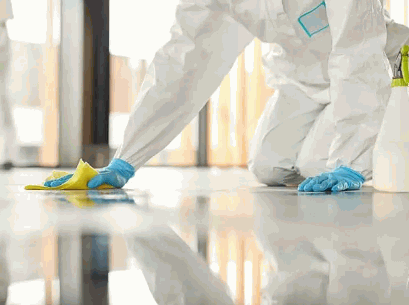
Regular Cleaning
Regular cleaning is crucial for maintaining the pristine appearance and hygienic quality of epoxy flooring in living rooms, ensuring a clean and allergen-free environment.
Dust, dirt, and other debris can accumulate on the surface of epoxy flooring, diminishing its shine over time if not regularly cleaned. Sweeping or vacuuming the floor on a weekly basis helps prevent the build-up of grime and maintains the floor’s aesthetic appeal.
For more thorough cleaning, mopping the epoxy floor using a mild detergent or specialised epoxy floor cleaner can effectively remove any stubborn stains or residue. Avoid using harsh chemicals, abrasive cleaners, or excessive water, as these can damage the epoxy coating.
Placing rugs or mats at entrances can help prevent excessive dirt from being tracked onto the floor, further preserving its beauty.
Avoiding Harsh Chemicals
To protect the finish and integrity of epoxy flooring in sitting rooms, it is essential to avoid strong chemicals and opt for cleaning products that are non-toxic and gentle on the surface.
Strong chemicals can strip away the topcoat of epoxy floors, leading to a dull appearance and compromising the durability of the flooring. Opting for eco-friendly cleaning solutions not only safeguards the beauty of your epoxy floors but also ensures a safe environment for your family and pets. Look for cleaning products labelled as safe for epoxy surfaces, as they are formulated to effectively remove dirt and stains without causing any damage. Regular maintenance with non-toxic cleaners can prolong the lifespan of your epoxy flooring and keep it looking brand new.
Touching Up Any Damages
Promptly addressing and touching up any damages on epoxy flooring is crucial to prevent further deterioration and maintain the floor’s pristine condition in the living room.
Not only does addressing damages promptly preserve the aesthetic appeal of the living room floor, but it also helps prevent any minor issues from escalating into larger and costlier problems.
Common damages to look out for include scratches, cracks, or discolouration. These can be remedied by cleaning the affected area thoroughly, applying a suitable epoxy repair kit, and ensuring proper sealing.
By taking proactive measures to repair any imperfections early on, homeowners can extend the lifespan and beauty of their epoxy floors, ensuring a durable and visually pleasing surface for years to come.




